The Classical World (93 page)
Read The Classical World Online
Authors: Robin Lane Fox

b) Roman soldiers lock shields in the ‘tortoise’-testudo formation against a Dacian fort.
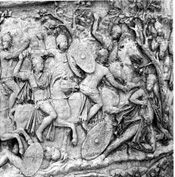
c) The Dacians’ leader Decebalus kills himself by a tree as Roman cavalry attack him.
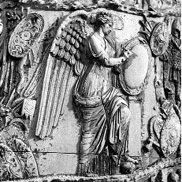
d) Victory inscribes a shield with Trajan’s successes for posterity.
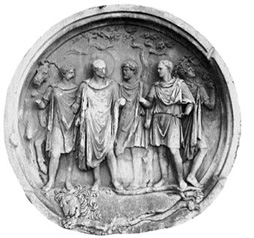
68. Tondo originally from a Hadrianic hunting-monument, Rome. Hadrian (
second left
) and possibly Antinous (
left
) with the lion they killed in West Egypt, in September
AD
130.
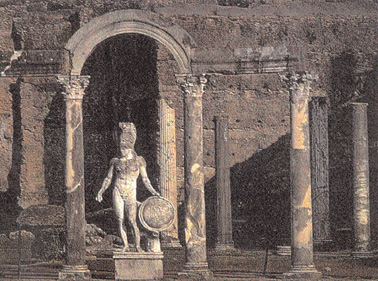
69. Replica statue of a beardless warrior, probably a Greek hero, not a war god, by the ‘Canopus’ canal, Hadrian’s villa at Tivoli,
c
.
AD
135.
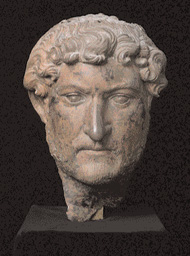
70. Bronze portrait head of Hadrian, second quarter of the second century ad.
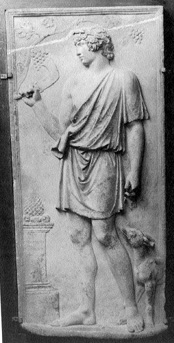
71. Relief of Hadrian’s beloved Antinous, deified, from near Lanuvium in Italy.
HADRIAN AND THE CLASSICAL WORLD
1
. Aulus Gellius, 19.8.5.
2
. J. M. C. Toynbee,
The Hadrianic School: A Chapter in the History of Greek Art
(1934).
3
. A. Spawforth, S. Walker, in
Journal of Roman Studies
(1985), 78–104, and (1986), 88–105, are still the fundamental studies.
4
.
Corpus Inscriptionum Latinarum
, 12.1122.
5
. Josephus,
Jewish War
2.385.
6
.
Historia Augusta
, Life of Hadrian 12.6.
7
. Tertullian,
Apology
5.7.
8
. William J. Macdonald, John A. Pinto,
Hadrian’s Villa and Its Legacy
(1995).
9
. R. Syme,
Fictional History Old and New: Hadrian
(1986, lecture), 20–21: ‘the notion that Hadrian, if anything, was an Epicurean may engender disquiet or annoyance.’ So far, it has not.
10
. Sophocles,
Antigone
821.
11
. F. D. Harvey, in
Classica et Mediaevalia
(1965), 101–46.
12
. Mary T. Boatwright,
Hadrian and the Cities of the Roman Empire
(2000), an excellent study whose bibliography is important for this book.
13
. Naphtali Lewis, in
Greek, Roman and Byzantine Studies
(1991), 267–80, with the history of the scholarly debate over authenticity.
14
. G. Daux, in
Bulletin de Correspondance Hellénique
(1970), 609–18, and in
Ancient Macedonia II
, Institute for Balkan Studies number 155 (1977), 320–23.
1.
HOMERIC EPIC
1
. L. Godart, A. Sacconi, in
Comptes Rendus de L’Académie des Inscriptions et Belles Lettres
(1998), 889–906, and (2001), 527–46.
2
. S. Mitchell, in
Journal of Roman Studies
(1990), 184–5, translating lines 40 ff. of C. Julius Demosthenes’ inscription at Oenoanda (
AD
124).
3
. Homer,
Iliad
6.528 and
Odyssey
17.323.
4
. Homer,
Iliad
2.270.
5
. Ibid. 16.384–92.
6
. Ibid. 18.507–8.
2.
THE GREEKS’ SETTLEMENTS
1
. M. H. Hansen, in M. H. Hansen (ed.),
A Comparative Study of Thirty City-state Cultures
(2000), 142–86, at 146.
2
. W. D. Niemeier, in
Aegaeum
(1999), 141–55.
3
. J. D. Hawkins, in
Anatolian Studies
(2000), 1–31.
4
. Plutarch,
Greek Questions
11.
5
. Pliny,
Natural History
19.10–11.
6
. S. Amigues, in
Revue Archéologique
(1988), 227.
7
. S. Amigues, in
Journal des Savants
(2004), 191–226, contesting the recently revived identification with
Cachrys ferulacea
.
8
. Diodorus, 13.81.5 and 83.3.
9
. T. J. Dunbabin,
The Western Greeks
(1948), 77 and 365.
10
. P. A. Hansen (ed.),
Carmina Epigraphica Graeca
, Volume I (1983), number 400: Robert Parker kindly cited this for me.
11
. J. Reynolds, in
Journal of Roman Studies
(1978), 113, lines 2–12, and, for the local side to it, see A. J. Spawforth and Susan Walker, ibid. (1986), 98–101, a fascinating study.
3.
ARISTOCRATS
1
. Hesiod,
Theogony
80–93 and
Works and Days
39.
2
. Aristotle,
Politics
1306A 15–20.
3
. Homer,
Iliad
3.222.
4
. O. Murray, in
Apoikia: scritti in onore di Giorgio Buchner
, AION n.s. 1 (1994), 47–54, for this dating.
5
. M. Vickers,
Greek Symposia
(Joint Association of Classical Teachers, London, n.d.).
6
. L. Foxhall, in Lynette G. Mitchell and P. J. Rhodes (eds.),
The Development of the Polis in Archaic Greece
(1997), 130, gives calculations, perhaps on the high end of the scale.
7
. Jacob Burckhardt,
The Greeks and Greek Civilization
, abridged and translated by Sheila Stern (1998), 179. I incline to his view, which is still controversial.
8
. H. W. Pleket, in Peter Garnsey, Keith Hopkins and C. R. Whittaker (eds.),
Trade in the Ancient Economy
(1983), 131–44, the model which essentially I follow on this vexed question throughout this book.
4.
THE IMMORTAL GODS
1
. Homer,
Iliad
23.75–6 and 100.
2
. Homeric
Hymn to Apollo
189–93.
3
. Erich Csapo,
Theories of Mythology
(2005), 165–71.
4
. Robert Parker, in J. Boardman, J. Griffin and O. Murray (eds.),
The Oxford History of the Classical World
(1986), 266.
5
. Homer,
Odyssey
11.241–4.
6
. Ibid. 11.251 and Homeric
Hymn to Aphrodite
286–9, with P. Maas,
Kleine Schriften
(1973), 66–7, implying the gods make love only to virgins. But Helen was not one.
7
. Prices from Attic data only, in M. H. Jameson, in
Proceedings of the Cambridge Philological Society
, supplementary volume 14 (1988), 91.
8
. Hesiod,
Theogony
418–52 with M. L. West’s
Commentary
(1971 edn.), 276–91.
9
. Homeric
Hymn to Apollo
390–end, with the remarkable study by W. G. Forrest, in
Bulletin de Correspondance Hellénique
(1956), 33–52.
10
. Adrienne Mayor, in
Archaeology
28 (1999), 32–40.
11
. W. G. Forrest, in
Historia
(1959), 174.
5.
TYRANTS AND LAWGIVERS
1
. Hesiod,
Works and Days
225–37.
2
. Chester G. Starr,
The Origins of Greek Civilization
(1962), part III, for the phrase I reapply here.
3
.
Anthologia Palatina
14.93.
